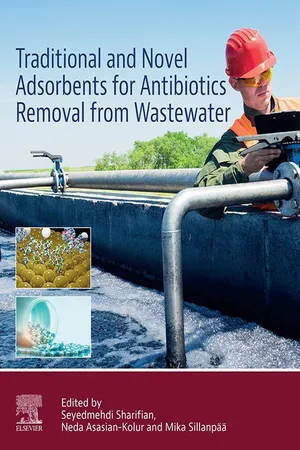
Traditional and Novel Adsorbents for Antibiotics Removal from Wastewater
Seyedmehdi Sharifian, Mika Sillanpää, Neda Asasian-Kolur, Seyedmehdi Sharifian,Mika Silanpää,Neda Asasian-Kolur,Mika Sillanpää
- 500 pages
- English
- ePUB (mobile friendly)
- Available on iOS & Android
Traditional and Novel Adsorbents for Antibiotics Removal from Wastewater
Seyedmehdi Sharifian, Mika Sillanpää, Neda Asasian-Kolur, Seyedmehdi Sharifian,Mika Silanpää,Neda Asasian-Kolur,Mika Sillanpää
About This Book
Traditional and Novel Adsorbents for Antibiotics Removal from Wastewater describes, in detail, the importance of removing antibiotics from aqueous systems, along with new information on their variation, solubility, toxicology and allowable concentration in groundwater. The book covers adsorption as an applicable method, highlighting its advantages and disadvantages. It investigates various adsorbents ranging from traditional activated carbons, modified forms of clays, metal oxides, polymer resins, and more advanced materials such as graphene-based, MOF, nano-matrices, and composite materials as potential sorbents for the adsorption of antibiotics from aqueous solutions.
In addition, the book covers biological microorganisms that have been used to remove antibiotics from wastewater and presents biopolymers, biowaste and living cells potentially and practically suitable for this purpose. For all adsorbents, the book explains preparation methods, main properties, modification techniques to increase antibiotic removal efficiency, mechanisms in antibiotic removal, advantages and limitations. It also presents adsorption-desorption in batch and continuous mode, optimized operating parameters, kinetic and equilibrium adsorption, and regeneration studies.
- Provides production and modification methods of conventional and non-conventional adsorbent materials for antibiotics adsorption from aqueous systems
- Considers the effects of antibiotics type and porous and chemical properties of adsorbents to improve the sorption capacity and ease of regeneration
- Features recent advances in the use of biowaste materials and biosorption processes for green removal of antibiotics from wastewater
Frequently asked questions
Information
Table of contents
- Cover image
- Title page
- Table of Contents
- Copyright
- List of contributors
- Chapter one. Adsorption: a reliable solution for emerging contaminants removal
- Chapter two. Adsorption process of antibiotics by carbon-based adsorbents
- Chapter three. Adsorption process of antibiotics by clay-based materials
- Chapter four. Adsorption process of antibiotics by novel adsorbents
- Chapter five. Biosorption process for antibiotics removal
- Chapter six. Hybrid technologies including adsorption for antibiotics removal
- Index